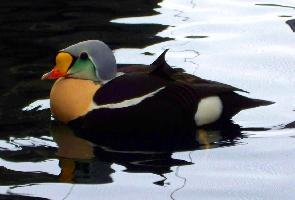
Greutăți și măsuri
| Lungime | de la 39 la 43 cm |
|---|---|
| Greutate | de la 410 la 650 g |
| Lungimea anvergurii aripilor | de la 60 la 67 cm |
Descrierea animalului
The Ferruginous Duck (Aythya nyroca), also known as the Ferruginous Pochard, is a medium-sized waterfowl species belonging to the family Anatidae. This attractive duck is notable for its distinctive plumage and relatively scarce status, making it a species of conservation concern in many parts of its range. The Ferruginous Duck is a migratory bird, with populations breeding in parts of Europe and Asia, and wintering further south in Africa and the Indian subcontinent.Adult Ferruginous Ducks typically measure between 38 to 42 centimeters in length, with a wingspan of approximately 70 to 80 centimeters. One of the most striking features of this species is its deep chestnut-brown plumage, which covers most of the body. The male, especially during the breeding season, exhibits a richer, more vivid hue compared to the female, who is slightly duller overall. Both sexes have a distinctive white undertail and a white patch at the rear of the flanks, which is particularly visible in flight. The bird's eyes are a striking white or pale yellow, contrasting sharply with the dark plumage and creating a captivating appearance. The bill is dark grey to black, and the legs and feet are greyish.
Ferruginous Ducks prefer shallow freshwater bodies, such as lakes, marshes, and slow-flowing rivers, with abundant vegetation. They are diving ducks, feeding underwater on a diet that includes aquatic plants, seeds, and, to a lesser extent, small aquatic animals like invertebrates and fish. Their feeding technique involves diving and swimming underwater to forage for food.
Breeding typically occurs in late spring and early summer. The Ferruginous Duck is somewhat unusual in its nesting habits among ducks, often choosing to nest in dense vegetation close to the water's edge, sometimes even in old nests of other birds or in tree holes. The female lays a clutch of 6 to 12 eggs, which she incubates for about three weeks. During this time, the male may stay nearby but does not participate in incubation. Once hatched, the ducklings are precocial, able to swim and feed themselves shortly after birth, but they remain under the watchful eye of the mother for several weeks until they are ready to fledge.
The Ferruginous Duck faces several threats across its range, including habitat loss due to the drainage of wetlands, pollution, and disturbance from human activities. In some areas, hunting also poses a significant threat to local populations. Conservation efforts are underway in many parts of its range to protect and restore suitable habitats, monitor populations, and regulate hunting to ensure the species' survival.
Despite its challenges, the Ferruginous Duck remains a symbol of the delicate balance of freshwater ecosystems, and its presence is a reminder of the importance of conserving natural habitats for the benefit of all species, including our own. With continued efforts, it is hoped that the populations of this beautiful and fascinating bird can be stabilized and even increased in the future.
Animale similare
Fotografii noi cu animale
Top 10 animale
- Dolphin gull (Leucophaeus scoresbii)
- Diana monkey (Cercopithecus diana)
- Moustached guenon (Cercopithecus cephus)
- Galápagos tortoise (Geochelone nigra complex)
- Japanese macaque (Macaca fuscata)
- Stone loach (Barbatula barbatula)
- Russian tortoise (Testudo horsfieldii)
- Common flying dragon (Draco volans)
- Greek tortoise (Testudo graeca)
- Vendace (Coregonus albula)


